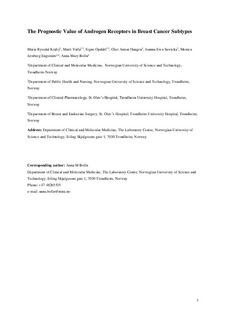| dc.contributor.author | Kraby, Maria Ryssdal | |
| dc.contributor.author | Valla, Marit | |
| dc.contributor.author | Opdahl, Signe | |
| dc.contributor.author | Haugen, Olav Anton | |
| dc.contributor.author | Sawicka, Joanna Ewa | |
| dc.contributor.author | Engstrøm, Monica J | |
| dc.contributor.author | Bofin, Anna M. | |
| dc.date.accessioned | 2019-02-22T07:51:39Z | |
| dc.date.available | 2019-02-22T07:51:39Z | |
| dc.date.created | 2018-10-01T15:47:51Z | |
| dc.date.issued | 2018 | |
| dc.identifier.citation | Breast Cancer Research and Treatment. 2018, 1-14. | nb_NO |
| dc.identifier.issn | 0167-6806 | |
| dc.identifier.uri | http://hdl.handle.net/11250/2586892 | |
| dc.description.abstract | Purpose
Androgen receptor (AR) expression is frequent in breast cancer and has been associated with good prognosis in several studies. The present study investigates AR-expression in relation to molecular subtypes, clinicopathological features and prognosis in 1297 primary tumours and 336 paired axillary lymph node metastases (LNM) from two cohorts of Norwegian patients.
Methods
Immunohistochemistry for AR was performed on tumours previously reclassified into molecular subtypes using immunohistochemistry and in situ hybridisation. Associations between AR-expression and clinical features were studied using Chi-square tests. Cumulative incidence of breast cancer death and Cox regression analyses were used to assess prognosis.
Results
AR-positivity was found in 78.0% of all cases, 84.9% of luminal and 45.1% of non-luminal tumours. The highest proportion of AR-positivity was found in Luminal B tumours, and the lowest in the Basal phenotype. Discordance in AR-status between primary tumours and lymph node metastases was observed in 21.4% of cases. A switch from AR− primary tumour to AR+ lymph node metastasis was seen in 60/72 discrepant cases. AR-expression in primary tumours was an independent and favourable prognostic marker (HR 0.70, 95% CI 0.55–0.90), particularly in the Luminal A subtype, and in grade 3 tumours.
Conclusions
AR is an independent predictor of good prognosis in BC, particularly in grade 3 and Luminal A tumours. Discordant AR-expression between primary tumour and LNM was observed in 21.4% of cases and most often there was a switch from AR− primary tumour to AR+ axillary LNM. | nb_NO |
| dc.language.iso | eng | nb_NO |
| dc.publisher | Springer Verlag | nb_NO |
| dc.title | The prognostic value of androgen receptors in breast cancer subtypes | nb_NO |
| dc.type | Journal article | nb_NO |
| dc.type | Peer reviewed | nb_NO |
| dc.description.version | acceptedVersion | nb_NO |
| dc.source.pagenumber | 1-14 | nb_NO |
| dc.source.journal | Breast Cancer Research and Treatment | nb_NO |
| dc.identifier.doi | 10.1007/s10549-018-4904-x | |
| dc.identifier.cristin | 1616877 | |
| dc.description.localcode | This is a post-peer-review, pre-copyedit version of an article published in [Breast Cancer Research and Treatment] Locked until 14.8.2019 due to copyright restrictions. The final authenticated version is available online at: https://doi.org/10.1007/s10549-018-4904-x | nb_NO |
| cristin.unitcode | 194,65,15,0 | |
| cristin.unitcode | 194,65,20,0 | |
| cristin.unitname | Institutt for klinisk og molekylær medisin | |
| cristin.unitname | Institutt for samfunnsmedisin og sykepleie | |
| cristin.ispublished | true | |
| cristin.fulltext | postprint | |
| cristin.qualitycode | 1 | |
